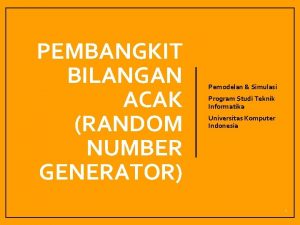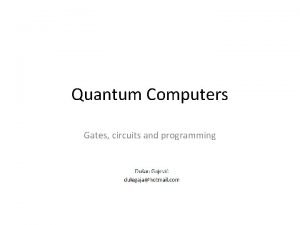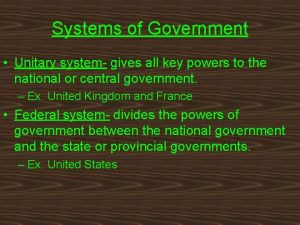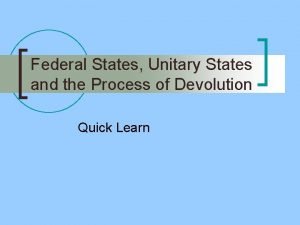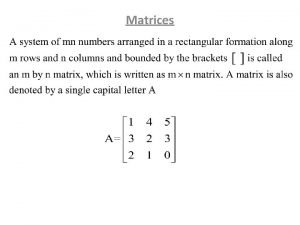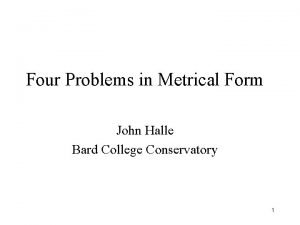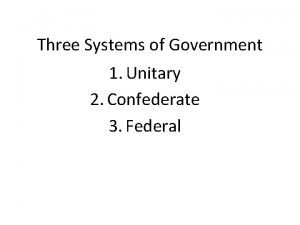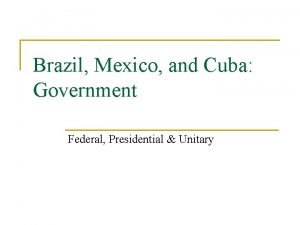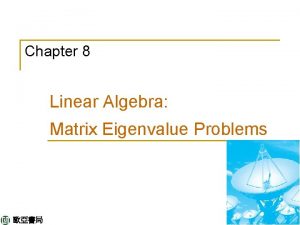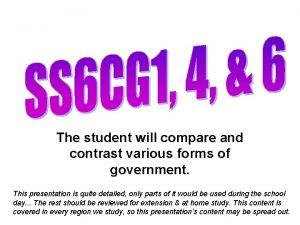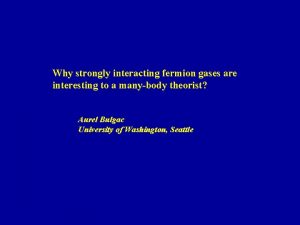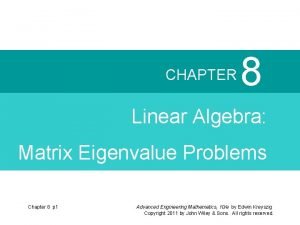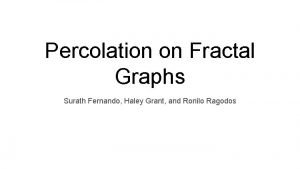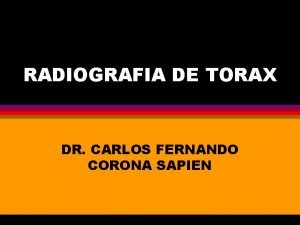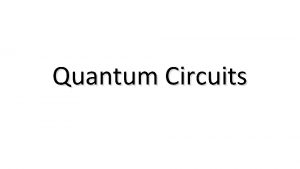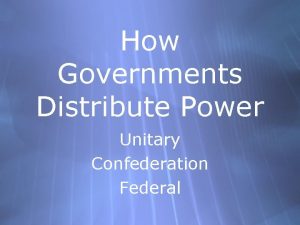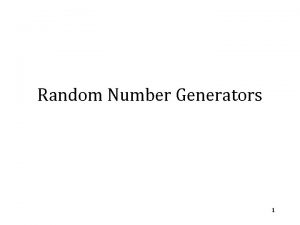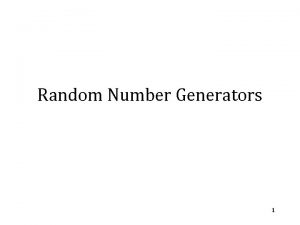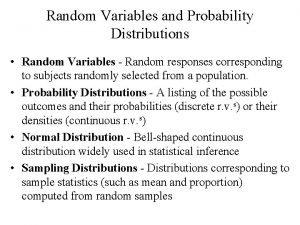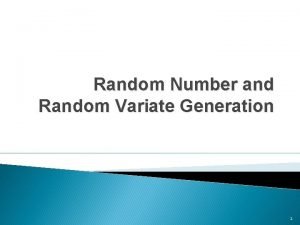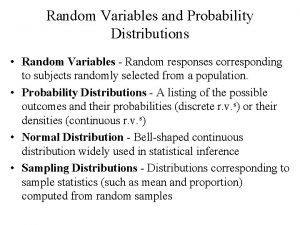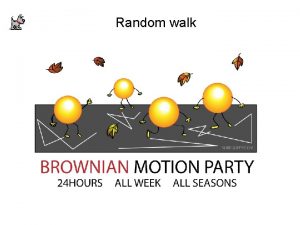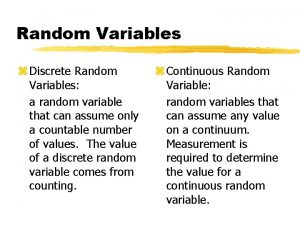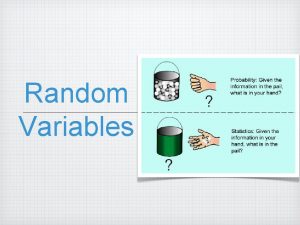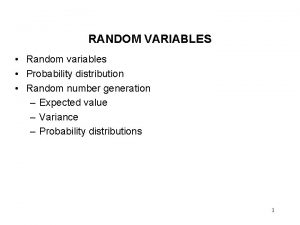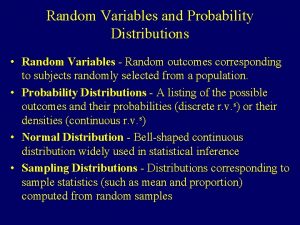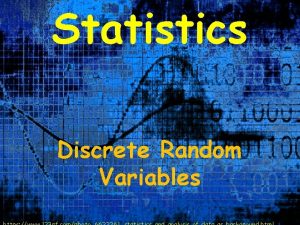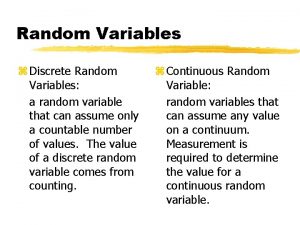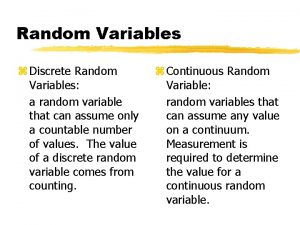Random Quantum Circuits are Unitary PolynomialDesigns Fernando G








































- Slides: 40

Random Quantum Circuits are Unitary Polynomial-Designs Fernando G. S. L. Brandão 1 Aram Harrow 2 Michal Horodecki 3 1. Universidade Federal de Minas Gerais, Brazil 2. University of Washington, USA 3. Gdansk University, Poland IQC, November 2011

Outline • The problem Unitary t-designs Random Circuits • Result Poly(n) Random Circuits are poly(n)-designs • Applications Fooling Small Sized Circuits Quick Equilibration by Unitary Dynamics • Proof Connection to Spectral Gap of Local Hamiltonian A Lower Bound on the Spectral Gap Path Coupling for the Unitary Group

Haar Random Unitaries For every integrable function in U(d) and every V in U(d) EU ~ Haarf(U) = EU ~ Haarf(VU)

Applications of Haar Unitaries (Hayden, Leung, Winter ‘ 04) Create entangled states with extreme properties (Emerson et al ‘ 04) Process tomography (Hayden et al ‘ 04) Quantum data hiding and information locking (Sen ‘ 05) State distinguishability (Abeyesinghe ‘ 06) Encode for transmission of quantum information through a quantum channel, state merging, mother protocol, …

The Price You Have to Pay… To sample from the Haar measure with error ε you need exp(4 n log(1/ε)) different unitaries Exponential amount of random bits and quantum gates…

Quantum Pseudo-Randomness In many applications, we can replace a Haar random unitary by pseudo-random unitaries: This talk: Quantum Unitary t-designs Def. An ensemble of unitaries {μ(d. U), U} in U(d) is an ε-approximate unitary t-design if for every monomial M = Up 1, q 1…Upt, qt. U*r 1, s 1…U*rt, st, |Eμ(M(U)) – EHaar(M(U))|≤ d-2 tε

Quantum Unitary Designs Conjecture 1. There are efficient ε-approximate unitary t-designs {μ(d. U), U} in U(2 n) Efficient means: • • unitaries created by poly(n, t, log(1/ε)) two-qubit gates μ(d. U) can be sampled in poly(n, t, log(1/ε)) time.

Quantum Unitary Designs Previous work: (Di. Vincenzo, Leung, Terhal ’ 02) Clifford group is an exact 2 -design (Dankert el al ’ 06) Efficient construction of 2 -design (Ambainis and Emerson ’ 07) Efficient construction of state poly(n)-design (Harrow and Low ’ 08) Efficient construction of (n/log(n))-design (Abeyesinghe ‘ 06) 2 -designs are enough for decoupling (Low ‘ 09) Other applications of t-design (mostly 2 -designs) replacing Haar unitaries

Random Quantum Circuits Local Random Circuit: in each step an index i in {1, … , n} is chosen uniformly at random and a twoqubits Haar unitary is applied to qubits i e i+1 Random Walk in U(2 n) (Another example: Kac’s random walk – toy model Boltzmann gas) Introduced in (Hayden and Preskill ’ 07) as a toy model for the dynamics of a black hole

Random Quantum Circuits Previous work: (Oliveira, Dalhsten, Plenio ’ 07) O(n 3) random circuits are 2 -designs (Harrow, Low ’ 08) O(n 2) random Circuits are 2 -designs for every universal gate set (Arnaud, Braun ’ 08) numerical evidence that O(nlog(n)) random circuits are unitary t-design (Znidaric ’ 08) connection with spectral gap of a mean-field Hamiltonian for 2 -designs (Brown, Viola ’ 09) connection with spectral gap of Hamiltonian for t-designs (B. , Horodecki ’ 10) O(n 2) local random circuits are 3 -designs

Random Quantum Circuits as tdesigns? Conjecture 2. Random Circuits of size poly(n, log(1/ε)) are an ε-approximate unitary poly(n)-design

Main Result Conjecture 2. Random Circuits of size poly(n, log(1/ε)) are an ε-approximate unitary poly(n)-design (B. , Harrow, Horodecki ’ 11) Local Random Circuits of size Õ(n 2 t 5 log(1/ε)) are an ε-approximate unitary t-design

Data Hiding Computational Data Hiding: “Most quantum states look maximally mixed for all polynomial sized circuits” e. g. most quantum states are useless for measurement based quantum computation (Gross et al ‘ 08, Bremner et al ‘ 08) Let QC(k) be the set of 2 -outcome POVM {A, I-A} that can Be implemented by a circuit with k gates

Data Hiding Computational Data Hiding: “Most quantum states look maximally mixed for all polynomial sized circuits” 1. By Levy’s Lemma, for every 0 < A < I, 2. There is a eps-net of size < exp(nlog(n)) for poly(n) implementable POVMs. By union bound

Data Hiding Computational Data Hiding: “Most quantum states look maximally mixed for all polynomial sized circuits” 1. By Levy’s Lemma, for every 0 < A < I, But most states also require 2 O(n) quantum gates to be approximately created… 2. There is a eps-net of size < exp(nlog(n)) for poly(n) implementable POVMs. By union bound

Efficient Data Hiding Corollary 1: Most quantum states formed by O(nk) circuits look maximally mixed for every circuit of size O(n(k+4)/6)

Efficient Data Hiding Corollary 1: Most quantum states formed by O(nk) circuits look maximally mixed for every circuit of size O(n(k+4)/6) Same idea (small probability + eps-net), but replace Levy’s lemma by a t-design bound from (Low ‘ 08): with t = s 1/6 n-1/3 and νs, n the measure on U(2 n) induced by s steps of the local random circuit model ε-net of POVMs with r gates has size exp(O(r(log(n)+log(1/ε)))

Circuit Minimization Problem Goal: Given a unitary, what is the minimum number of gates needed to approximate it to an error ε? Circuit Complexity: Cε(U) : = min{k : there exists V with k gates s. t. ||V – U||≤ε} Question: Lower bound to the circuit complexity? Corollary 2: Most circuits of size O(nk) have Cε(U) > O(n(k+4)/6)

Haar Randomness Not Needed More generally, Any quantum algorithm that has m uses of a Haar unitary and l gates and accepts, on average, with probability p, will accept with probability in (p – ε, p + ε) if we replace the Haar unitary by a random circuit of size poly(m, l, log(1/ε))

Equilibration by Unitary Dynamics Problem: Let HSE be a Hamiltonian of two quantum systems, S and E with |S| << |E| State at time t: S On physical grounds we expect that for most times This is true, in the limit of infinite times! (Linden et al ‘ 08) E

Fast Equilibration by Unitary Dynamics How about the time scale of equilibration? For which T do we have (Linden et al ‘ 08) only gives the bound T ≤ 1/(min. energy gap) But we know equilibration is fast: coffee gets cold quickly, beer gets warm quickly

Fast Equilibration by Unitary Dynamics Toy model for equilibration: Let HSE = UDU’, with U taken from the Haar measure in U(|S||E|) and D : = diag(E 1, E 2, …. ). (B. , Ciwiklinski et al ‘ 11, Masanes et al ‘ 11, Vinayak, Znidaric ‘ 11) Time of equilibration: Average energy gap: For typical eigenvalue distribution goes with O(1/log(|E|))

Fast Equilibration by Unitary Dynamics Calculation only involves 4 th moments: Can replace Haar measure by an approximate unitary 4 -design Corollary 3. For most Hamiltonians of the form UDU’ with U a random quantum circuit of O(n 3) size, small subsystems equilibrate fast.

Fast Equilibration vs Diagonalizing Complexity Let H = UDU’, with D diagonal. Then we call Cε(U) the diagonalizing complexity of U. Corollary 4. For most Hamiltonians with O(n 3) diagonalizing complexity, small subsystems equilibrate fast. Connection suggested in (Masanes, Roncaglia, Acin ‘ 11) In contrast: Hamitonians with O(n) diagonalizing complexity Do not equilibrate in general Open question: Can we prove something for the more interesting case of few-body Hamiltonians?

Proof of Main Result 1. Another characterization of unitary t-designs 2. Mapping the problem to bounding spectral gap of a Local Hamiltonian 3. Technique for bounding spectral gap “It suffices to get a exponential small bound on the convergence rate” 4. Path Coupling applied to the unitary group

t-Copy Tensor Product Quantum Expanders An ensemble of unitaries {μ(d. U), U} is an (t, 1 -ε) tensor product expander if Obs: Implies it is a d 2 tε-approximate unitary t-design

Relating to Spectral Gap μn : measure on U(2 n) induced by one step of the local random circuit model (μn)*k : k-fold convolution of μn (measure induced by k steps of the local random circuit model) We show:

Relating to Spectral Gap μn : measure on U(2 n) induced by one step of the local random circuit model (μn)*k : k-fold convolution of μn (measure induced by k steps of the local random circuit model) We show: It suffices to a prove upper bound on λ 2 of the form 1 – Ω(t-4 n-1) since (1 – Ω(t-4 n-2))k ≤ 2 -2 ntε for k = O(n 2 t 5 log(1/ε))

Relating to Spectral Gap But So with and Δ(Hn, t) the spectral gap of the local Hamiltonian Hn, t: h 2, 3

Relating to Spectral Gap But So with Want to lower bound spectral gap by O(t-4) and Δ(Hn, t) the spectral gap of the local Hamiltonian Hn, t: h 2, 3

Structure of Hn, t i. The minimum eigenvalue of Hn, t is zero and the zero eigenspace is ii. Approximate orthogonality of permutation matrices:

Structure of Hn, t Follows from i. The minimum eigenvalue of Hn, t is zero and the zero eigenspace is ii. Approximate orthogonality of permutation matrices:

Structure of Hn, t Follows from i. The minimum eigenvalue of Hn, t is zero and the zero eigenspace is Follows from ii. Approximate orthogonality of permutation matrices:

Lower Bounding Δ(Hn, t) We prove: Follows from structure of Hn, t and (Nachtergaele ‘ 96) Suppose there exists l, nl, εl such that for all nl < m < n-1 with A 1 : = [1, m-l-1], A 2: =[m-l, m-1], B: =m and εl<l-1/2. Then

Lower Bounding Δ(Hn, t) We prove: Follows. Want from structure to lower bound of Hn, t by and. O(t-4), an exponential small bound in the size of the chain (i. e. in 2 log(t)) (Nachtergaele ‘ 96) Suppose there exists l, nl, εl such that for all nl < m < n-1 with A 1 : = [1, m-l-1], A 2: =[m-l, m-1], B: =m and εl<l-1/2. Then

Exponentially Small Bound to Spectral Gap Follows from two relations: 1. Wasserstein distance: 2.

Bounding Convergence with Path Coupling Key result to 2 nd relation: Extension to the unitary group of Bubley and Dyer path coupling Let (Oliveira ‘ 07) Let ν be a measure in U(d) s. t. Then

Bounding Convergence with Path Coupling Key result to 2 nd relation: Extension to the unitary Must in path n steps of the walk to get groupconsider of Bubleycoupling and Dyer coupling non trivial contraction (see paper for details) Let (Oliveira ‘ 07) Let ν be a measure in U(d) s. t. Then

Summary • Õ(n 2 t 5 log(1/ε)) local random circuits are ε-approximate unitary t-designs • Most states of size nk is indistinguishable from maximally mixed by all circuits of size n(k+4)/6 • Proof is based on (i) connection to spectral gap local Hamiltonian (ii) approximate orthogonality of permutation matrices (iii) path coupling for the unitary group • Another application to fast equilibration of quantum systems by unitary dynamics with an environment

Open Questions • Is Õ(n 2 t 5 log(1/ε)) tight? • Can we prove that constant depth random circuits are approximate unitary t-designs? (we can show they form a t-tensor product expander; proof uses the detectability lemma of Aharonov et al) Would have applications to: (i) fast equilibration of generic few-body Hamiltonians (ii) creation of topological order by short circuits (counterpart to the no-go result of Bravyi, Hastings, Verstraete for short local circuits)
 Insidan region jh
Insidan region jh Current in a parallel circuit
Current in a parallel circuit Quantum physics vs quantum mechanics
Quantum physics vs quantum mechanics Quantum physics vs quantum mechanics
Quantum physics vs quantum mechanics Quantum random number generator
Quantum random number generator Geiger
Geiger Random assignment vs random selection
Random assignment vs random selection Random assignment vs random sampling
Random assignment vs random sampling Unitary definition
Unitary definition What is a unitary system of government
What is a unitary system of government T gate quantum
T gate quantum Martha rogers concepts
Martha rogers concepts Price elasticity of supply
Price elasticity of supply In which system are all key powers
In which system are all key powers Unitary systems
Unitary systems Unitary method
Unitary method Unitary form organizational structure
Unitary form organizational structure Inverse of transpose
Inverse of transpose The farmer in the dell unitary or strophic
The farmer in the dell unitary or strophic Lie2d
Lie2d Is japan a unitary state
Is japan a unitary state Types of federalism
Types of federalism Federal system
Federal system Is cuba federal or unitary
Is cuba federal or unitary Unitary form organizational structure
Unitary form organizational structure Unitary demand
Unitary demand How is power distributed in a unitary government
How is power distributed in a unitary government Unitary elastic demand
Unitary elastic demand Example of a skew symmetric matrix
Example of a skew symmetric matrix Unitary form organizational structure
Unitary form organizational structure Parliamentary system vs presidential system
Parliamentary system vs presidential system The power of politics
The power of politics Unitary method
Unitary method What is a unitary system of government
What is a unitary system of government Unitary fermi gas
Unitary fermi gas Defensive realism
Defensive realism Eigenvalue of matrix 2x2
Eigenvalue of matrix 2x2 Dr fernando moura oncologista
Dr fernando moura oncologista Fernando tel
Fernando tel Surath fernando
Surath fernando Cisuritis
Cisuritis




